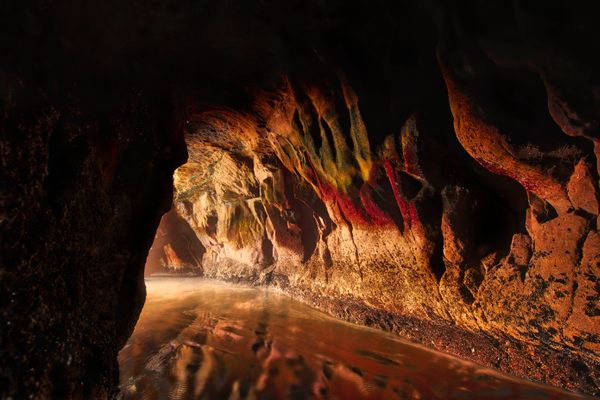Mexico’s Newest Nature Reserve Will Be a Former Prison
Octavio Aburto and other Mexican ecologists want to preserve the pristine reefs of the Isla Marías penal colony.

When Octavio Aburto first dived into the sea surrounding the prison, he saw a nearly pristine underwater jungle. Pink and purple sea fans as large as a person sprouted out of coral-crusted boulders. A shimmering meadow of garden eels poked out of the seafloor. Huge schools of snappers, jacks, and reef fish swooped in and out of the reef. It was one of the most untouched reefs that Aburto has seen in his 20 years as a marine biologist working in the Gulf of California, and he would do anything he could to keep it that way.
For the past nine years, Aburto and his colleagues have been pushing for the Mexican government to protect the entire island archipelago that encompasses Isla María Madre before the region falls into environmental degradation from overfishing and wildlife tracking.
Towering above these waters is the recently shuttered Islas Marías Federal Penal Colony, the last island prison in the northern hemisphere, according to a report by the Associated Press. In February 2019, President Andrés Manuel López Obrador of Mexico announced he would close Islas Marías and relocate around two-thirds of the remaining 659 inmates and free the remaining third. The overcrowded prison was no longer profitable, people had begun to riot, and the old facilities could not withstand the whipping winds of worsening hurricanes, the AP reported. The island would become a cultural and environmental education center, named for Isla Marías’s most notable occupant, the communist revolutionary José Revueltas.

But this, according to Aburto and a coalition of Mexican ecologists, is not enough. In Aburto’s experience, similar declarations have only restricted the terrestrial parts of an island, but left the surrounding ocean vulnerable to human exploitation. “The island is a very special natural laboratory,” Aburto says. “We have a special opportunity to recover the marine resources in this archipelago.”
The Isla Marías Federal Penal Colony sits on the largest of four islands in the Isla Marías archipelago, located around 70 miles off the Pacific coast of Mexico’s Nayarit’s state. The colony was constructed in 1905 under the controversial regime of Porfirio Díaz, intended to isolate political prisoners such as socialists. In its early decades, the prison became infamous for brutality, torture, and repression, according to a statement made by López Obrador. In recent years, Isla Marías adopted a tamer mode of detention, often holding lower-risk inmates with a history of good behavior or those on track to be released soon.
But the golden age of the island penal colony has long since passed. In 1946, France began to empty the deadly Devil’s Island prison in French Guiana. In the 1980s, Chile closed its Santa Maria prison and an insurgency led Peru to close El Frontón. In the 1990s, Costa Rica and Brazil closed two island prisons. Many of these sites have since become nature reserves or tourist attractions, according to a 2005 report in the Los Angeles Times.

Despite what you might think, prisons and nature reserves go hand in hand, according to Joe Roman, a conservation biologist at the University of Vermont in Burlington. “Prisons function in two ways: They’re designed to keep people in and keep people out,” Roman says. “And in the wide spaces between those areas, in the absence of humans, wildlife can actually flourish.” Even landlocked prisons or demilitarized zones can create what is functionally a geographic island, preserving nature by virtue of an area’s isolation from the interference of human activity. Roman points to the demilitarized zone between North and South Korea as a prime example. In the case of Isla Marías, the wide, navy-patrolled radius of protection around the island functioned as a no-fishing zone, inadvertently allowing reefs to flourish.
In Aburto’s eyes, Isla Marías was always a prime candidate for conservation. In his two decades of work as a marine biologist, Aburto saw the entire Gulf of California overrun by overfishing. He wondered if any pristine reefs remained in the gulf. If they did, he realized, they’d be by Isla Marías. So in 2009, Aburto requested permits to dive off the shores of the colony. He received approval a year later. After a two-hour boat ride from the nearby city of San Blas, Aburto had to pass an inspection where Mexican soldiers and marines jumped on the boat to check for weapons. Only then could his team finally enter the waters around the entrance to the prison (they were forbidden to go inside). A navy boat tailed them the whole time.
Though the reefs bore some evidence of human interference, as Aburto expected, he was surprised to see absolutely untouched sandy bottoms that seemed to have never been trawled or exploited by humans. Isla Marías exists somewhere in the transition zone between the colder Gulf of California and the warmer Pacific Ocean, resulting in a strange and beautiful rocky reef landscape covered in hard corals, Aburto says. “It was so beautiful, the things we were able to see,” Aburto says. “Different from all other reefs that have been overfished.” The only thing noticeably missing were bull sharks and hammerheads, larger predators that were likely affected by overfishing in the surrounding area.

Although the colony left Isla Marías’s seascape in superlative condition, it was less kind to the island’s landscape. Workers cut down many of the island’s tropical hardwoods to build the colony, and the prison inadvertently introduced invasive species such as feral goats, dogs, and cats, according to a report in the AP.
Isla Marías is home to the Tres Marías amazon, an endangered species of parrot found nowhere else on Earth. The people incarcerated at Isla Marías often captured these parrots so their relatives could smuggle them out and sell them on the mainland, Ramon Ojeda Mestre, who served as Isla Marías’s head of the environmental recovery program, told the AP. Mestre had long been working to turn the prison into a reserve, but his efforts fell apart in 2005, when the government escalated what is now known as Mexico’s War on Drugs. As the country cracked down on drug cartels, the prison system teemed with inmates and the government reaffirmed the need to keep Isla Marías open and at capacity. The colony also wrecked the natural population of boa constrictors, as incarcerated people would frequently kill the snakes to make belts out of their skins. The other three islands in the archipelago, however, boast thriving colonies of blue-footed boobies and other seabirds.
And then there’s the issue of the prison structure itself, which has yet to be torn down. Incarcerated people were allowed to build their own homes, resulting in a number of houses, as well as a school and clinic, within the grounds of the prison. In 2012, the administration began building a maximum security prison, a project that never came to fruition, Aburto says. So the island contains a hodgepodge of abandoned buildings in various levels of decay.

Aburto doesn’t know if the government plans to tear down the buildings or simply leave them to be swallowed by the jungle. The latter approach has precedence: In 2005, Panama converted the prison on Coiba Island, the penultimate island prison in the Americas, into a national park but did not tear down any buildings. According to the park’s website, “The remaining structure is slowly being reclaimed by jungle and the marine air. Its crumbling buildings and simply marked graves serve as the only memorial to Coiba’s dark history.”
In 2000, the Mexican government deemed roughly 150 square miles of the Islas Marías archipelago a marine protected area. But the reserve still allowed fishing and its other protections were rarely enforced, resulting in a park that only exists on paper, Aburto says. “Basically they declared it was a protected area but it’s not actually protected,” he adds.
So Aburto and his colleagues want Islas Marías’s new status as a cultural and education center to include a strict ecological management plan that will be enforced to protect the archipelago’s biodiversity. The researchers’ plan will delineate clear protections for both the land and sea within the archipelago and bar all fishing activities. The final decision, however, lies in the hands of the federal government.

When reclaiming any prison or formerly militarized zone, Roman believes countries shouldn’t erase the often ugly history of these areas. “It’s important to acknowledge human history and to allow nature to thrive in areas where it already had a foothold,” Roman says, adding that commemorating history can often allow countries with historical conflict to develop peaceful relations. True to his word, Roman has helped lead a campaign to transform Guantanamo Bay into an international ecology lab. Unsurprisingly, efforts have stalled under the current administration, Roman says.
But while Guantanamo’s fate hangs very much in the air, Isla Marías will be converted to an education center—at least, at some point. López Obrador has not released a concrete timeline. According to Aburto, officials from the Mexican government have started working on a management plan for the island that López Obrador will eventually need to approve. For now, Aburto and his colleagues hope to exert as much influence as possible to push the management plan in the direction of greater protection, enforcement, and surveillance of Isla Marías’s marine biodiversity.
After all, the longer the island remains unoccupied, the more danger the island faces from illegal fishing and wildlife trafficking. When Aburto returned to the archipelago in 2018, he discovered hundreds of drilled conch shells littering the seafloor—the remnants of fishermen on the hunt for snails, according to a story in Nature. In other words, the clock is ticking. “Isla Marías has endemic species that you cannot see in other parts of the planet,” Aburto says. “For humans, we not only should admire and respect that evolution, but also use that uniqueness to teach future generations on the importance of preserving biodiversity.” As Roman puts it, Aburto’s team is playing conservation offense—he just hopes the government is game.

























Follow us on Twitter to get the latest on the world's hidden wonders.
Like us on Facebook to get the latest on the world's hidden wonders.
Follow us on Twitter Like us on Facebook